NEGenWeb Project
Church/Catholic
Franciscans
![]()
![]()
![]() PLATTE COUNTY
PLATTE COUNTY![]()
![]()
![]()
Chapter IV
PLATTE COUNTY
From the versatile pen of Platte County's first historian, I. N. Taylor, well-known early figure of Central Nebraska, we have the skeleton of events that have transpired during 1856-1876 on these plains. It was in 1876, on the occasion of the centennial celebration of the birth of the American nation, that Isaac N. Taylor, then selling land and doing a bit of surveying, on the side, in and about Columbus, conceived the idea of sketching the happenings in Platte County during the first twenty years of its existence. His little eighteen-page sketch has become one of the most authentic sources of Nebraska history of seventy years ago. As he himself noted, however, the sketch was much too short to give just credit to the romantic side of the County's early life. Much of that is already lost to posterity, and, in again writing of Platte County, the authors can only draw together many early day sketches and reminiscences and pick from them the cream information. This sketch, also, is, of necessity, too short to include anything but a portion of the material on hand.
The plains in Platte County had been frequently crossed by hunter and immigrant as early as 1810 and 1820, but there was nothing here to tempt the eager people as they pushed their way to the places abounding in fur-bearing animals and to populated settlements which sprang up along the Pacific coast and inland at an early date.
A MISSIONARY AMONG THE PAWNEES
It was in the year 1834 when the Reverend John Dunbar and Samuel Allis, both of Palmer, Massachusetts, arrived at Fort Leavenworth, near the Missouri River, on their way to do missionary work among the Pawnee Indians of Central Nebraska. Eventually, these two gentlemen found themselves with the tribal bands of Chiefs Pitalesharu and Sacherishu, of which tribes they were soon made members. In 1839 Reverend Dunbar established a school and mission in the Pawnee nation and conducted it for four years, up to the time the Pawnees were driven away by the Dakotas.
THE SITE OF THE MISSION
There is a question as to the exact location of the very first missionary school in this section of Nebraska. Some claim that it was on the present site of the City of Columbus, while others think it was somewhere in the Cedar Valley southeast of Fullerton. It is probable that the latter comes closer to being the exact position, as that vicinity is thought to have harbored a great collection of Indian huts and tepees long before the white men came to Nebraska and
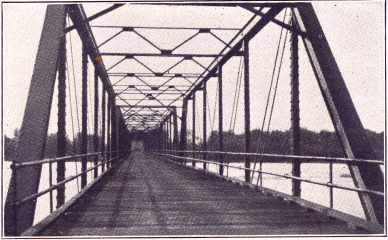
Bridge near Monroe, Nebraska
25
![]()
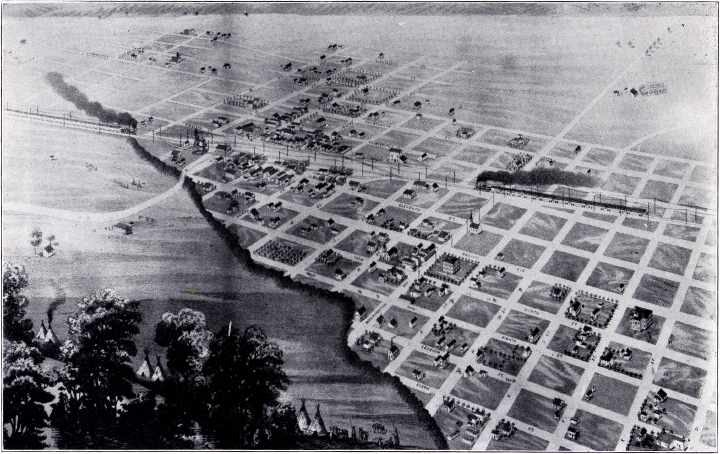
Bird's-eye View of Columbus, A. D., 1874. By Aug. Koch. Original in County Treasurers Office, Columbus
26
![]()
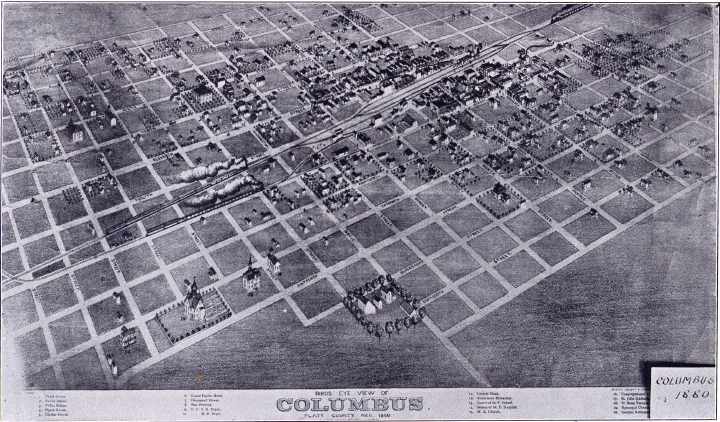
Bird's-eye View of Columbus, Nebraska, A. D. 1880. Courtesy of F. L. Gootschalk, County Surveyor.
27
![]()
was still the home of the Pawnees, when immigrants began to cross the Plains.
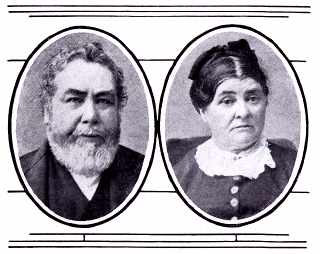
Mr. and Mrs. John Haney.
THE FIRST PERMANENT SETTLING OF PLATTE COUNTY
In 1856 a company was formed in Omaha for the purpose of making a settlement some fifty miles from Omaha. The names of General Estabrook and. Colonel Miller are mentioned as being associated with this company. As representatives of this group of men, Isaac Albertson and E. W. Toncray set out in April, 1856, towards the setting sun. On May 27, 1856, they arrived on the east bank of Shell Creek, a little above its entrance into the Platte River, and decided that, insofar as they had surely gone more than fifty miles and found no better location till then, they would throw down their loads and straightforward make the spot their home. Amid proper solemnity, the two adventurers named the town-to-be "Buchanan", in honor of the gentleman then at the head of the American nation. The founding of Columbus itself will be related in a chapter reserved for that purpose.
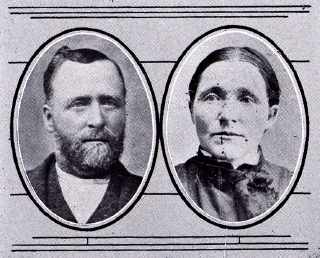
Mr. and Mrs. James Haney
The land where Albertson and Toncray settled is no longer part of Platte County, having been given to Colfax County when it was organized in 1868. At that time an act of the Legislature took from Platte County all of the East three Ranges. These two men are credited with being Platte County's first settlers, however, because their homes were first in the County. Isaac Albertson became prominent in the political life of both counties. He was the first elected county judge of Platte County and later, when his land was included in Colfax, represented several eastern counties in the Legislature.
28
![]()
THE FIRST TOWNS
As we shall see later on, Columbus was the first permanent town to be organized in Platte County, having been located a few weeks after the attempt at Buchanan. The town of Cleveland was laid out on a gorgeous scale, two and a half miles northwest of Columbus, in 1857, by George W. Stevens, William H. Stevens and Michael Sweeney. There was, for a time, a possibility that the new site might develop into a town of considerable size, since the location was, in some respects; better than that of Columbus. Cleveland wound up in queer fashion. In 1866, George Francis Train, the greatest financial wizard ever harbored in Columbus, bought the entire town, placed it on rollers and moved it into Columbus. The well-known Indian trader, L. W. Platt, also began a town at his beautiful country home, which he called "Zigzag". Platt died in 1875 and his dream of a town went with him. The ranch settlement of Joseph Russell, west of Schuyler, known as "Neenah", was known far and wide as a gathering place for immigrants, also lost its glory at the death of its last owner, a Mrs. Wells.
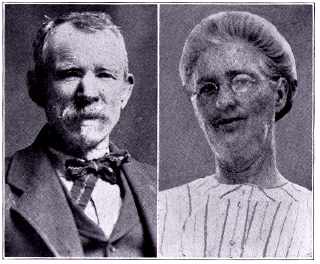
Mr. and Mrs. Pat Lyons.
THE FIRST DOCTOR
The first medical doctor of Platte County was probably Dr. Charles B. Stillman. He was born in New Haven, Connecticut, in 1831, and came
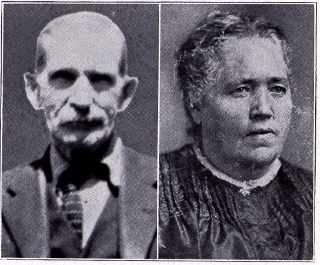
Mr. and Mrs. John Quinn.
west to Iowa with his parents while he was still a child. In 1856 he graduated from the Iowa Medical University and came to Omaha the following spring. In March, 1857, Doctor Stillman, in company with George W. Hewitt, walked from Omaha to Columbus. The men often remarked that the journey from the Missouri was a perilous one, the snow being three feet deep most of the way and the weather cold. Arriving here, Doctor Stillman opened a drug store in connection with his medical prac-
29
![]()
tice, thus becoming the first druggist in the county, also. For nine years Doctor Stillman was the only graduate doctor in the county. He was, moreover, the first justice of the peace, served as the second county clerk and as mayor of Columbus. In many ways he showed his intelligent interest in the community he had chosen to serve. Dr. Stillman died April 14, 1894, mourned by all who knew him.
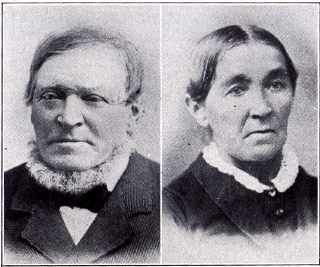
Mr. and Mrs. Franz Henggeler.
ORGANIZATION OF PLATTE COUNTY
History tells us that in August, 1857, the counties of Platte and Monroe were organized. Judge Smith of Fremont issued a proclamation calling for an election of county officials and the location of county-seats. In Platte County the result of this first election was as follows: Probate Judge, Isaac Albertson; Clerk, George W. Hewitt; Recorder, J. P. Becker; Treasurer, Vincent Kummer: Sheriff. Cyrus Tollman: Justice of the Peace, Charles B. Stillman; Constable, Jacob Guter. County Commissioners, Gustavus Becher, George Spaulding and Abram Root. Monroe County: Probate Judge, Charles H. Whaley; Clerk, George W. Stevens; Recorder, G. E. Yeaton; Treasurer, C. Whaley; Sheriff, N. Davis; Representative, Leander Gerrard; Surveyor, P. Kimball; County Commissioners, H. Peck, C. H. Pierce and H. J. Hudson.
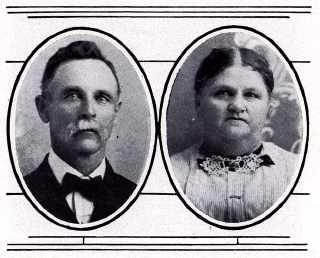
Mr. and Mrs. Joseph Henggeler.
MONROE COUNTY JOINS PLATTE COUNTY
The first election in Monroe County was also the last held there. Almost as soon as the county was organized agitation arose to tack it onto Platte. A petition was gotten up, headed by John Rickley of Platte and George W. Stevens of Monroe, which was presented at the Territorial Legislature sitting in the winter of 1858-1859. It was signed by practically every voter in both counties.
30
![]()
THOSE WHO CAME FIRST
Immediately after the settlement at Columbus, people flocked to the country around, taking claims. Of the twelve founders of Columbus, to be spoken of later on, it is said that Vincent Kummer was the only one who did not bother about procuring some of the nearby land for himself. Carl Reinke, one of the twelve, ventured the farthest out, locating six miles north and four miles east of Columbus.
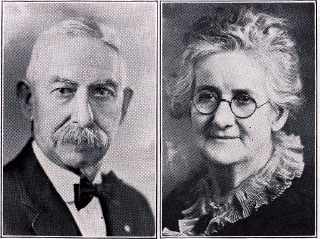
Mr. and Mrs. Thos. McTaggert.
acquiring 463 acres there. Reinke was the very first person to settle in that territory for many miles around, and many were the immigrants and squatters he aided in the goodness of his heart. Henry Lusche, also a member of the twelve, soon followed Reinke's lead.
It was to these two places that George Berney, a picturesque Swiss adventurer who had tended cattle in Germany, worked in a hotel in Italy, soldiered in a European revolution, cut lumber in Wisconsin, worked on a New Orleans
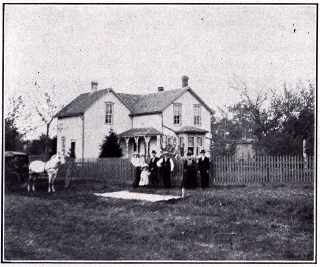
The Berney Home
river steamer, and as a stone mason in Omaha, finally made his way. Berney was a very active spirit and figured immediately in the affairs of the community. One of his most unique experiences was the building of a "fence" near Shell Creek. Not having any material for a fence, a number of settlers contracted with Berney to dig them a ditch two miles long and
31
![]()
deep enough to head off live stock. Berney dug the ditch, taking almost a year to finish, and nearly starved on the job.
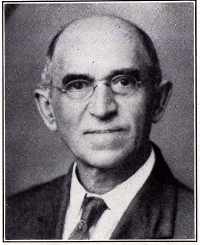
Godfrey Frischolz.
After hauling hay for the government at Denver and freighting between Omaha and Denver, Berney finally drifted back to Columbus, married Miss Rosa Henggeler, and took to raising hogs end cattle on a large scale. Berney commenced his live stock raising venture in Platte county in 1865, and to him is due a great deal of the inspiration given to scores of other Platte county farmers who took to raising hogs and cattle. He has the distinction of having shipped the first corn-fed cattle out of Platte county, sending them to the Chicago market.
WHERE THE PEOPLE SETTLED
In 1857, 1858 and 1859, the German colony, already swelled to a greater number than that of any other nationality, received the families of Held, Rickert, Henggeler, Ahrens, Mattis and Loseke. The Irish received Hayes, Doody and
Mr. Geo. Berney, Mrs. Geo. (Rosa Henggeler) Berney. |
Joe. Berney. |
the Carrigs. To the eastern settlement, now included in Colfax county, came Nelson Toncray, Williams, Davis and Robert Carson, while still farther up settled Rolfer, Skinner, Kemp, Clough, Spaulding and Fayls.
The Galley family at first intended to live on land near Salt Lake, but decided to settle here. James Galley with his three sons, George W., James H., and Samuel, as well as his two sons-in-law, William Draper and John Barrow, came in September, 1859. W. A. McAllister came a trifle later. All of these families settled at various points in Platte county. McAllister used to recall that, in those first years, before the railroad went through, very little grain was raised, chiefly because the threshing was difficult and the market too far away. All of the grain from the Elkhorn river to Grand Island was threshed by Jim Lee of Fremont, who operated the only threshing machine in this part of Nebraska. Jumps of 30 to 40 miles were often made between jobs, for the simple
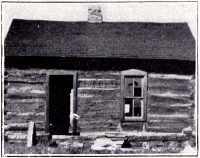
Wolfel-Krumei Log House. Now in Pawnee Park
reason that no one lived closer than that. The few grist mills in the territory were life savers in truth, for that was the only way the people could turn their crop into edible form, and the mills did a flourishing business, draw-
32
![]()
ing trade, at times, from as far as a hundred miles.
THE GLADDENITES
In 1860 Platte county opened its arms to a white-haired, old man whose name was simply Gladden. There is a legend that his mother
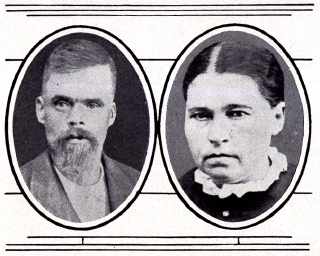
Mr. and Mrs. B. Caffrey.
named him 'Gladden" before he was born, because a message from heaven suposedly (sic) told her that he was to gladden the hearts of the world's people with his gospel. Gladden followed the Mormons to Nauvoo, but was discredited by Brigham Young, and accordingly, with a few followers, including the families of Platt, Stowe, Sellars, Gallup, Coon and Hoagland settled near Monroe, establishing a sort of commune. Things prospered for a time, but a lawsuit with Leander Gerrard about a steer broke up the commune, and the people there commenced to scatter among their neighbors.
THE MORMONS AND THEIR TROUBLES
Leander Gerrard, one of central Nebraska's most prominent pioneers, drove his stakes on Looking Glass Creek, near the center of old Monroe county, now part of Platte county, on the first day of May, 1857. While Gerrard was on his way to the U. S. Land office to have his claim recorded, Whaley, Pierce and Baty, then Ray, Swicker and Henderson jumped his claim. Then a party of Mormons jumped them all. Upon his return, finding his land so much in
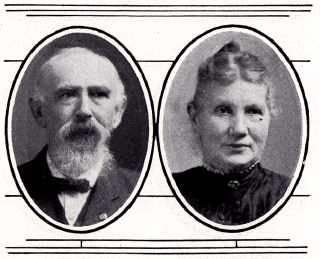
Mr. and Mrs. Wm. Schilz.
demand, Gerrard made a truce with Whaley and Ray and drove out the Mormons, thereby securing for themselves some very choice farm land.
The Mormons moved farther north to Genoa and commenced there one of the finest settle-
33
![]()
ments to be found anywhere in Nebraska at that time. They enclosed 2,000 acres with a ditch and sod fence and broke and planted 1,200 acres. History tells us that before this wonderful first crop was ready for use, many of the destitute Mormons were starving. But that sod crop saved the lives of a great many of that peaceful people, as sod crops were saving the lives of countless others who were finding hard times on the Plains.
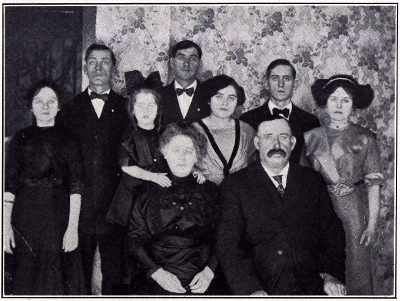
The Martin Costello Family.
The Mormons were pursued by hard luck. Their lot was always bad, and, as an example of conditions at Genoa, it is said that Mrs. Preston, for many years a resident of Columbus, gave birth to her first child, Erasmus, in a hut without a roof, during a drenching rain, and that for three weeks the only food in the house were cucumbers and parsley.
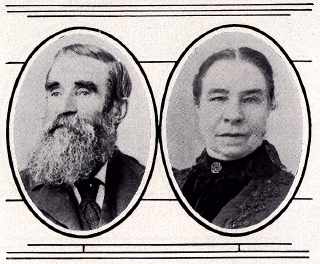
Mr. and Mrs. Larry Byrnes.
THE END OF THE MORMONS
In 1852 the United States government set aside a Pawnee Reservation, five by thirty miles in area, commencing at the mouth of the Beaver and stretching west along the Loup river. In the Sixties the Mormons were ordered off their new settlement and all their efforts were in vain. The colonists scattered to the four winds, entirely heartbroken. By this rending of the settlement, Columbus received some very fine people. Chief among them was Henry J.
34
![]()
Hudson, a leader of the Mormons and establisher of the Mormon Church in Columbus.
Hudson conducted a store for many years and successively held the office
of justice of the peace, postmaster, county superintendent of schools, county
clerk, county commissioner and supervisor, and city police judge. He was
one of the incorporators of the Columbus cemetery and assisted in laying
the first body to rest there, that of James McFadden. The families of Charles
Brindley, James Warner, Moses Welch, Peter Murie, Mrs. Carl Reinke and Mrs.
Freston were among the Mormons remaining in Platte county.
SOME OTHER EARLY FOLKS
A group of Yankees, mostly from New York State, found their Mecca on the land south of the Loup, around its junction with the Platte,
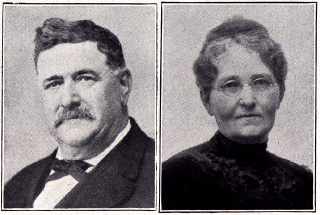
Mr. and Mrs. Dan Kavanaugh.
and farther west. The first of these were the families of Barnum, Clother, the Beebe Brothers, Stevens, Morse, Perry, Clark, Cushing and Witchie. It is interesting to note that, in the succeeding years, these Yankees were mostly replaced by German and Swiss immigrants. In those days a proud man was Guy C. Barnum, who came here in 1860. Barnum was the only Democrat in the Territorial Legislature in those days, and merry were the times he had in chastising the Republican host. The Peter Myer family settled here in 1857 and made county history. Peter Myer was a freighter and through that advantage, Mrs. Myer enjoyed the distinction of being mistress of the first frame house erected in Platte County.
THE FIRST FLAG AND ITS MAKER
Mrs. Myer had been born in Ireland, but was always a warm American patriot. She was the second white woman to settle in Platte County, Mrs. J. C. Wolfel being the first. Mrs. Myer worked very hard. The family farmed on Shell Creek and homesteaded on the Loup for eleven years. While on the Loup some people found a three-day old infant that had been left on the prairie to die. Mrs. Myer, not having any children of her own, adopted the babe and reared it as her son. John W. Myer died in 1912. History does not tell us on what occasion, but it is accepted that Mrs. Ellen Myer, the Irish immigrant, made by hand the first United States flag in Platte County. She died in 1918, being 90 years old at her death.
The authors cannot attempt to even mention all of the first pioneers of Platte County. Another group of early settlers will be mentioned in the Chapters on Columbus, and the other towns of the county. We have tried to mention, however, many of the families that settled in Platte County prior to 1860, since they are the real pioneers. It would take a large volume to mention even those who came from1860 to 1875, for a great many of those first families are extinct or have removed from these parts.
The valuable archives of The Columbus Journal, edited so many years by Platte County's dean of newspapermen, Moses K. Turner, and the history of the County, from the pen of I. N. Taylor, published in 1876, are sources of material for the data of the past pages. These two sources are widely used in this Sketch.
OUR FIRST NEWSPAPERS
The first newspaper printed in Platte County was The Columbus Golden Age, launched by the town's first newspaper man, C. C. Strawn, on June 21, 1866. It died of mortgage with its twelfth number. The second attempt was successful. O. T. B. Williams started The Platte Journal in 1869. Within a year M. K. Turner and Company bought it and changed its name to The Columbus Journal, the first edition under the new name appearing May 11, 1870. It continued for many years under the Turner guidance, and was the lineal antecedent of The Col-
35
![]()
umbus Daily News, which The Telegram Company bought from John I. Long, then its owner and editor, and consolidated with The Telegram when the latter was converted from a weekly to a daily about seven years ago.
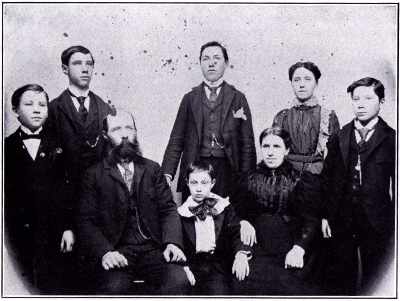
The Nicholas Adamy Family.
Judge W. N. Hensley, whose death occurred in 1929, founded The Columbus Era, in February, 1874, and made it democratic in politics. The Columbus Journal was Republican in its beliefs, as was also The Columbus Republican, which was founded by Frank P. Burgess in 1875, and which was later removed under a different management to David City. The first newspaper, in the German language, in Columbus, was founded by R. C. Lange about 1878 and was called the 'Columbus Wochenblatt'. It later became the Nebraska Biene. In June, 1918, Leopold Jaeggi, then its owner and publisher, discontinued its publication on account of war conditions.
The various newspapers in the towns and villages of Platte County were not started until several years later, and will be treated in the Chapter on those towns and villages.
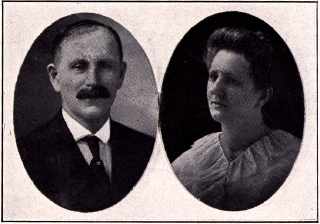
Mr. and Mrs. H. Abts.
THE FIRST MARRIAGE IN PLATTE COUNTY
Police Judge John Ratterman was county judge of Platte County for many years, and to him the author is indebted for information concerning the first marriages in Platte County.
In the oldest record book in the county judge's office, a quaint volume written in legal form long since obsolete, Judge Ratterman found the first recorded marriage in Platte County to be that of John Will and Marie Rickert, on July 5, 1858.
36
![]()
The permit to wed is unique in form and character. It reads: "Territory of Nebraska, Platte County. Whereas, it has been duly shown to my satisfaction that there is no legal impediment existing to the marriage of Mr. John Will and Miss Marie Rickert, both of Platte County, therefore, marriage license is this day issued."
The permit is signed by A. P. Pattison, as County Judge.
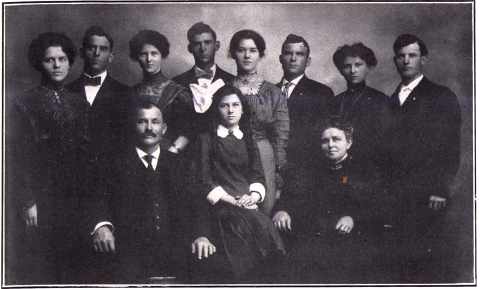
The Louis Schroeder Family.
The marriage certificate itself certainly contains no red tape. It simply reads: "I here certify that I did on the fifth day of July, 1858, solemnize the marriage of Mr. John Will and Miss Marie Rickert, both of Platte County, at the house of Peter Meyer in said county, in presence of Mrs. Ellen Meyer." The certificate bears the signature of C. B. Stillman as justice of the peace.
The Will-Rickert license was the only one issued in 1858. The next record was that of James E. North and Nelly Arnold, issued on February 17, 1859, when George Hewitt was county judge. These two young people were married on horseback on the streets of Columbus.
Four licenses to wed were issued in 1859. The next year had only three. Of the eight marriages in Platte County up to that time, only one was performed by a minister. In 1861 five permits were given, and seven in 1862. At the present time the figure is from two to four permits a week, proving that Cupid, with more targets to shoot at, is considerably busier and luckier than he was 75 years ago.
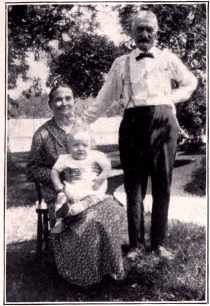
Mr. and Mrs. Jos. Gutzmer.
TROUBLE WITH THE INDIANS
When the Pawnee Indians were removed to the old Mormon confines along the Loup at Genoa, there were, for a time, no disturbances of the public peace. At times, however, passions ran wild, especially when the thieving Pawnees became too bold. At the Quinn place, six miles south of Columbus, a Pawnee was shot and killed by Mr. Quinn when caught for the third time stealing grain. The Indians rushed down from Genoa, full of fight, but a stern
37
![]()
threat from the assembled whites pacified the Pawnees, who retired satisfied with the gift of a pony and six sacks of flour. A similar incident occurred at Guy Barnum's farm. Someone in his employ killed an Indian, and the Pawnees swarmed over the place menacingly, demanding about every movable thing in retribution. The timely appearance of Barnum himself, armed with a huge club, drove them all away.
The Indians had so learned to respect white law and order that as early as 1862, so says I. N. Taylor, one brave white woman could drive a dozen Pawnee men from her presence with only a whip.
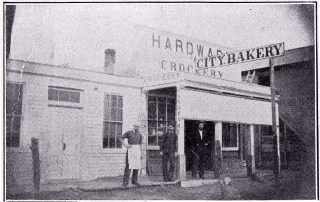
Some Old Columbus Stores.
THE LOOKING GLASS MASSACRE
Hardly had the Pawnees learned their lesson, when a new deadly foe loomed across the northern horizon. The Sioux, always warlike, began to commit horrible crimes at many places in Nebraska. It was not until the 'Looking Glass Massacre" of 1864 that the people of Platte County began to realize the seriousness of the Sioux menace. The incidents of the massacre are pitiable.
Pat Murray, with his brother-in-law, Adam Smith, large land owners just west of Columbus, had set up a camp on the Looking Glass near Genoa, putting up hay for the government. They had several hired men with them, and Mrs. Murray was cooking for them. One evening, at dusk, 25 Arapahoe Indians rode into camp, asking for food. Mr. Murray was away for the night, having gone to Columbus for supplies, but Mrs. Murray gave the Indians what food they wished. That done, they began to untie the work horses. An old man tried to intervene, and was immediately brained and scalped. A boy who had hidden himself in a hay pile escaped the poisoned arrows of the murderers.
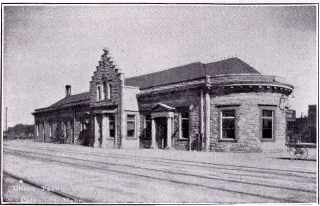
The Union Pacific Depot at Columbus.
Mrs. Murray herself tried to defend the property with a pitch fork and was riddled with arrows. Believing her dead, the Indians ransacked the camp of what they could carry and left. Mrs. Murray dragged herself into the tall damp weeds and spent a night of terrible agony. She had been wounded in the hip and limped the rest of her life.
Some men at a nearby farm who had heard the uproar went to the camp to investigate, and carried away the dead and wounded. They could not find Mrs. Murray and thought the Indians had carried her away, but she was found
38
![]()
the next day, almost dead. She lay near death's door for weeks, but lived several years after her terrible experience, never fully recovering from the shock and wounds.
Although the Indians were trailed for a long while by the soldiers stationed at Genoa, they made good their escape, and were never brought to justice. The Arapahoes took with them about $2,500 worth of Murray's property when they perpetrated their dastardly crime. The U. S. government in 1892 reimbursed the Adam Smith family.
COLUMBUS BECOMES A WAR FORT
A short time after the Looking Glass Massacre a stranger passing through Columbus gave out the warning that a band of forty Sioux were seen by him in a thicket between the two rivers not far from the town. I. N. Taylor, in his refreshing manner, goes on to tell the story:
"The whole valley from Kearney to Omaha was wild with alarm. Nearly the whole population left their homes, with their live stock and more valuable effects. Many, between Kearney and Columbus, left for the season and halted at Elkhorn City. At Grand Island, Columbus and Elkhorn the people made a stand and built blockades. J. L. Martin, now of Merrick County, very characteristic (sic) of 'Pap Martin', but very unmilitarily, named these stockades. The Grand Island was "Fort Sauer Kraut"; Columbus, "Fort Sock-It-To-Em", and Elkhorn was "Fort Skeedaddle". We have to submit to the unchangeable names of history. But Columbus can stand it if the rest of them can.
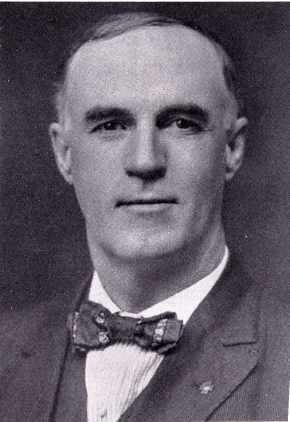
Mark Burke, Ex-Sheriff of Platte County.
"For two weeks most of Platte County, people and beasts, were within the stockade. And may heaven hide such sights from our eyes, and such experience from our lives forever thereafter.
"A home guard was organized with J. S. Taylor, captain; E. W. Arnold, first lieutenant; J. A. Baker, second lieutenant, and J. B. Beebe, orderly sergeant. A guard stood watch during the nights, and patrols swept the prairie during the day.
"But no Indians came. Perhaps our movements saved us, for Indians, more than civilized warriors, know at a distance the situation of enemies. And this was the last Indian scare we have had."
The above quotation is from Taylor's Platte County history, written in 1876. There have not been any alarming Indian troubles in this section of Nebraska since that date.
39
![]()
THE EARLY BUSINESS WORLD
Frank Becker commenced the first general store in Columbus shortly after the town was settled. Vincent Kummer had, however, kept a stock of supplies for sale at a shack along the river almost from the time the first men came here. The stores were all supplied by means of the overland freight trains, whose teamsters hauled all of the goods in from Omaha, the usual source of supplies. The Union Pacific did not go through Columbus until ten years later.
Charles Bremer built the first brewery in Platte County in 1864, locating at Columbus, while Jonas Welch and John Peter Becker opened the first grist mill on Shell Creek in 1867. The Platte Valley Mill, four miles south of Columbus, was started by Messrs. Schaup and Glade in 1877. In 1880 a cheese factory was proposed by a gentleman from Illinois. He declared that to make his factory a success he needed the milk from 200 cows, for which he could pay two cents a quart. A survey was made and 200 cows could not be found in all the territory about whose owners could spare the milk.
A FEW DREAMS
In 1874 there was much agitation by the local chapter of the National Grange for the construction of a huge $100,000 water power plant on the Loup River at Columbus. It was to be owned by farmers of Platte County and was to be used for manufacturing purposes, chiefly for domestic consumption. It was planned that 500 farmers should take out shares amounting to $200 each. The project died from want of enthusiasm when the stock was ready to be sold, one of the reasons being that the grasshoppers' first invasion came in 1874.
The same year saw the capitalization of a $10,000 corporation known as The Platte County Coal-Boring Company. Its mission was to bore for coal in Platte County, which commodity was supposed to exist here. It, too, proved a failure; for no coal made its appearance. Likewise went The Columbus Foundry, started in 1874 by Withers and Schroeder. About a ton of cast iron was made as a test. It later developed that it was too costly to manufacture cast iron on the Plains, coke being $200 a car-load, and the plant was too far from the base of supplies.
WHAT BECAME OF THE MEAT PACKING INDUSTRY
A pork packing plant and stockyards corporation, capitalised (sic) (sic) at $100,008 was announced March 24, 1880, with R. H. Henry, J. P. Becker,
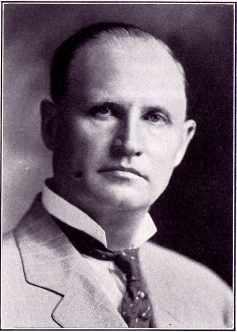
Christian M. Gruenther.
David Anderson, Leander Gerrard, Abner Turner and J. C. Morrisey as chief incorporators. The Columbus Packing Company's building was put up then at a cost of about $9,000, with additional money being wrapped up in equipment. The establishment was run three seasons by the proprietors themselves and one year by a lessee. In the height of its business life it killed as many as 10,000 hogs in one season, involving a disbursement of about $100,000. At that time there were from 30 to 40 men and boys working there.
This building stood between the Union Pacific and the Burlington tracks east of the city. After it was abandoned, the building was a hangout for tramps and transient characters of all sorts. A blaze on April 22, 1891, wiped out the building and with it went the dream of a meat-packing business for Columbus.
PLATTE COUNTY'S FIRST COURT HOUSE
Shortly before Nebraska became a State, in 1867, the Territorial Legislature passed an Act allowing Platte County to make a loan of $16,000 to finance the building of a courthouse, providing a vote of the majority was in favor of it. Times were hard and many people looked askance at the huge debt to be piled onto the weak county. The Civil War was just over, too, and there was no money in the country. The election was held on April 22, 1867, and resulted
40
![]()
in 96 votes for and 29 against. This vote covered the whole of Platte County. Work on the first courthouse was begun at once. C. A. Speice was selected to draw up the plans for the courthouse and jail, two separate buildings. The county commissioners, consisting of John Kelly, chairman, F. G. Becher and Nelson Toncray, were evidently pleased with Speice's labors, for they accepted the plans and allowed him $50 for his trouble. The lowest bid was $18,000, submitted by J. P. Becker of Columbus, who was awarded the contract. The buildings were completed in the spring of 1870 and served continuously for 52 years, until the present splendid new structure was put up.
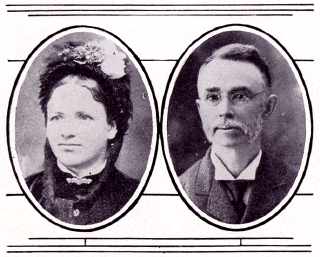
Mr. and Mrs. Ed. Fitzpatrick.
PLATTE COUNTY'S NEW COURTHOUSE
Platte County's new courthouse was dedicated with formal ceremonies, Monday, June 26, 1922. Concerts by the Humphrey and Columbus bands, songs by the Columbus Maennerchor, quartet singing by Messrs. Rohde, Evans, Larson and Purnell, and music by Schaecher's orchestra, of Lindsay were on the program. The list of speakers was headed by Hon. S. H. McKelvie, Governor of Nebraska. Other addresses delivered were by Otto F. Walter, County Attorney, Mrs. R. M. Campbell and G. W. Phillips.
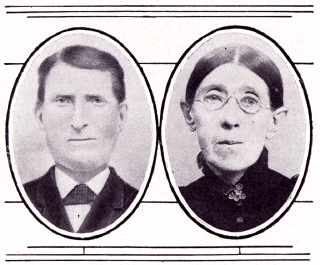
Mr. and Mrs. Henry Carrig.
The actual cost of the building itself was $293,471.96, excluding the site, furniture, litigation and other incidental expenses. The total cost of the furniture was $28,777.68 and the total cost of the site and improving grounds was $20,944.47, making a grand total cost of Platte County's new court house to be $343,194.11.
Platte County's board of supervisors at the time of the building was as follows: Henry Hob-
41
![]()
|
|||